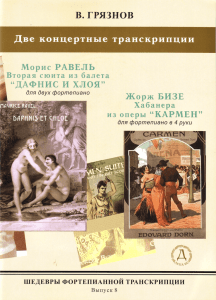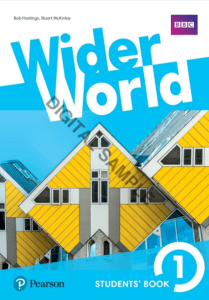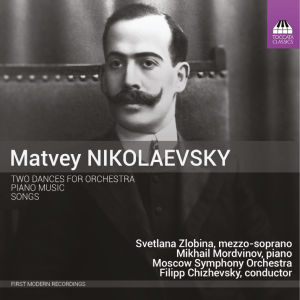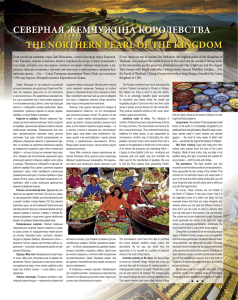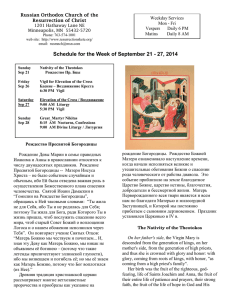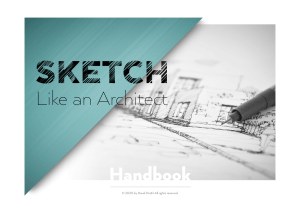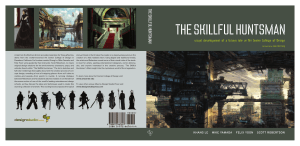9785737903701-1
реклама
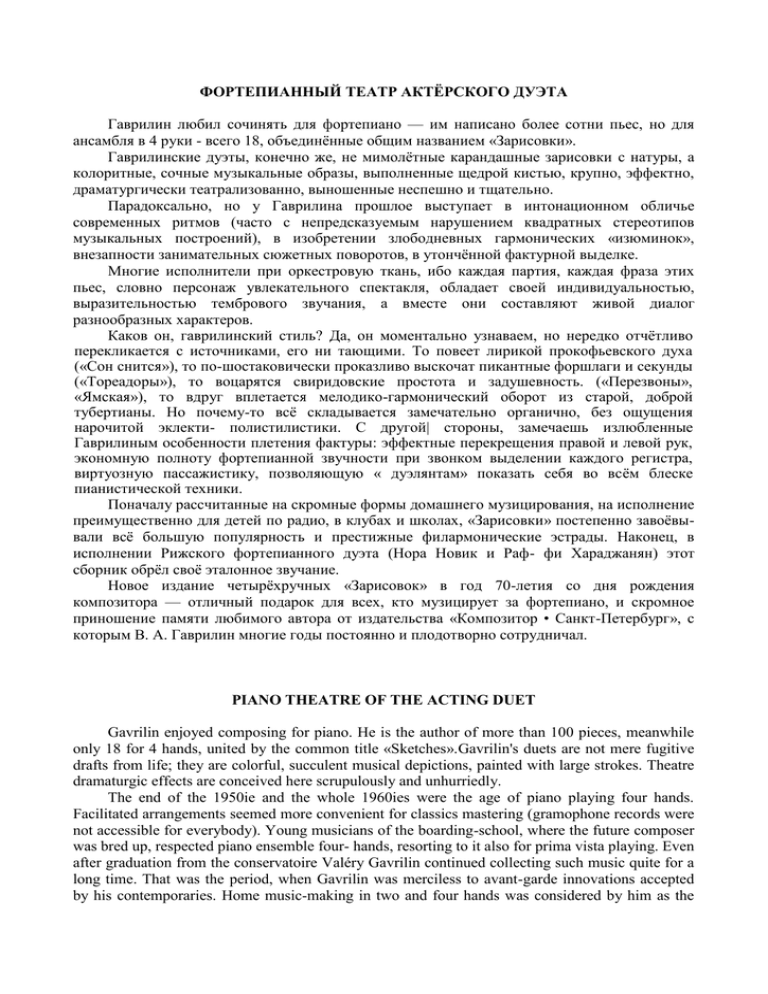
ФОРТЕПИАННЫЙ ТЕАТР АКТЁРСКОГО ДУЭТА Гаврилин любил сочинять для фортепиано — им написано более сотни пьес, но для ансамбля в 4 руки - всего 18, объединённые общим названием «Зарисовки». Гаврилинские дуэты, конечно же, не мимолётные карандашные зарисовки с натуры, а колоритные, сочные музыкальные образы, выполненные щедрой кистью, крупно, эффектно, драматургически театрализованно, выношенные неспешно и тщательно. Парадоксально, но у Гаврилина прошлое выступает в интонационном обличье современных ритмов (часто с непредсказуемым нарушением квадратных стереотипов музыкальных построений), в изобретении злободневных гармонических «изюминок», внезапности занимательных сюжетных поворотов, в утончённой фактурной выделке. Многие исполнители при оркестровую ткань, ибо каждая партия, каждая фраза этих пьес, словно персонаж увлекательного спектакля, обладает своей индивидуальностью, выразительностью тембрового звучания, а вместе они составляют живой диалог разнообразных характеров. Каков он, гаврилинский стиль? Да, он моментально узнаваем, но нередко отчётливо перекликается с источниками, его ни тающими. То повеет лирикой прокофьевского духа («Сон снится»), то по-шостаковически проказливо выскочат пикантные форшлаги и секунды («Тореадоры»), то воцарятся свиридовские простота и задушевность. («Перезвоны», «Ямская»), то вдруг вплетается мелодико-гармонический оборот из старой, доброй тубертианы. Но почему-то всё складывается замечательно органично, без ощущения нарочитой эклекти- полистилистики. С другой| стороны, замечаешь излюбленные Гаврилиным особенности плетения фактуры: эффектные перекрещения правой и левой рук, экономную полноту фортепианной звучности при звонком выделении каждого регистра, виртуозную пассажистику, позволяющую « дуэлянтам» показать себя во всём блеске пианистической техники. Поначалу рассчитанные на скромные формы домашнего музицирования, на исполнение преимущественно для детей по радио, в клубах и школах, «Зарисовки» постепенно завоёвывали всё большую популярность и престижные филармонические эстрады. Наконец, в исполнении Рижского фортепианного дуэта (Нора Новик и Раф- фи Хараджанян) этот сборник обрёл своё эталонное звучание. Новое издание четырёхручных «Зарисовок» в год 70-летия со дня рождения композитора — отличный подарок для всех, кто музицирует за фортепиано, и скромное приношение памяти любимого автора от издательства «Композитор • Санкт-Петербург», с которым В. А. Гаврилин многие годы постоянно и плодотворно сотрудничал. PIANO THEATRE OF THE ACTING DUET Gavrilin enjoyed composing for piano. He is the author of more than 100 pieces, meanwhile only 18 for 4 hands, united by the common title «Sketches».Gavrilin's duets are not mere fugitive drafts from life; they are colorful, succulent musical depictions, painted with large strokes. Theatre dramaturgic effects are conceived here scrupulously and unhurriedly. The end of the 1950ie and the whole 1960ies were the age of piano playing four hands. Facilitated arrangements seemed more convenient for classics mastering (gramophone records were not accessible for everybody). Young musicians of the boarding-school, where the future composer was bred up, respected piano ensemble four- hands, resorting to it also for prima vista playing. Even after graduation from the conservatoire Valéry Gavrilin continued collecting such music quite for a long time. That was the period, when Gavrilin was merciless to avant-garde innovations accepted by his contemporaries. Home music-making in two and four hands was considered by him as the remedy for to revive high chamber tradition. He began with expressive programmatic piano pieces, most clear by texture and phrasing. However, piano ensembles were more preferable for him to be performed in concerts. Piano ensemble music is used to be composed as facilitated arrangements of some complicated opuses. Gavrilin's repertoire consisted of only original compositions. Russian songs and romances describing coachmen's and draymen's life Gavrilin knew about it and responded to this subject. Four ensembles opening his collection poetize old-timed carters, their utility and characters. The «Chimes» in this little suite is simply the imitation of jingling bells on the" harness. No premonition about the future choral symphony-action rises... Motley, decorated, vigorous world of carnival personages forms the other side of this collection. Wending musketeers, elegant toreadors, dancers whirled by impetuous Tarantella, sudden stamps and mockery leaps in sparkling Galop and finally that simple-hearted graceful pas in the «Imitation of Antiquity». Turbulent composer's imagination invents theatre masks of fine characters living long ago. What an irony is concealed in these scenes of the past imbibed with modern rhythms and intonations. Very often square constructions are broken. The author gives birth to fashionable harmonies, sudden enthralling turns and polished texture. Here it is — our life, however, reverberated through the iridescent prism of its festive mood: «Merry Stroll», «March», «Marching Song», mostly lyrical «Lonesome Harmonist». The composer denies the idea of frightening reality showed to his compatriots, although having undergone true sufferings. Therefore his sharp dissonances, dynamic chiaroscuros are not anguishing and burning. Experts and inexperienced listeners are fondled by abundant picturesque phonations. Nowadays the Waltz by Gavrilin enjoys its popularity both as ever-green piano ensemble and the arrangement for symphony orchestra and other instrumental casts. The Waltz from the ballet «House near the Road» (after A. T. Tvardovsky's poem of the same name), written originally for symphony orchestra, enters this publication as the piano four hands transcription fulfilled by Stanislav Gorkovenko, People's Artist of Russia, having conducted the first TV ballet-performances with Gavrilin's music. What is Gavrilin's manner? Of course, it's instantly recognized. Sometimes it is fed by Prokofiev's lyricism («Watching the Dream»), Shostakovich's ridiculous poignant grace-notes and seconds («Toreadors»), Sviridov's simplicity and openheartedness («Chimes», «Coachmen's Quarter»), Shuibert's gallant harmonic turns. How natural do these elements suit each other in Gavrilin's manner, deprived of any stylistic eclecticism. This is his talent's enigma! Nevertheless, Gavrilin resorts to his favorite textual methods: virtuoso hands crosses, reasonable dynamic abundance, clearly marked registers, brilliant velocity. Pianists duelists are given the chance of their skill to be stated. The «Sketches» were firstly proposed as unpretentious forms of home music-making, mainly for children's clubs and schools, or broadcasted by radio. It was realized, when the distinguished Leningrad pianist ZinaidaYakovlevna Vitkind invited Gavrilin for mutual performances. However, the «Sketches» were continued stopping show at the philharmonic stage. The Riga Piano Duo, Nora Novik and Raffi Haradzhanyan, bred by the Leningrad piano school, were captivated by this music, having proposed excellent interpretation of the whole collection. What are the main advantages of their performing? Perfect dramaturgic theatre element, accomplished ensemble of acting musicians, inexhaustible aspiration for inventions. The new edition of piano «Sketches» in four hands is the true present for those, whose passion is piano music- making. This is also the modest offering of the Compozitor Publishing House • Saint-Petersburg to its most beloved author Valéry Gavrilin, having devoted to it many wonderful years of his life.

